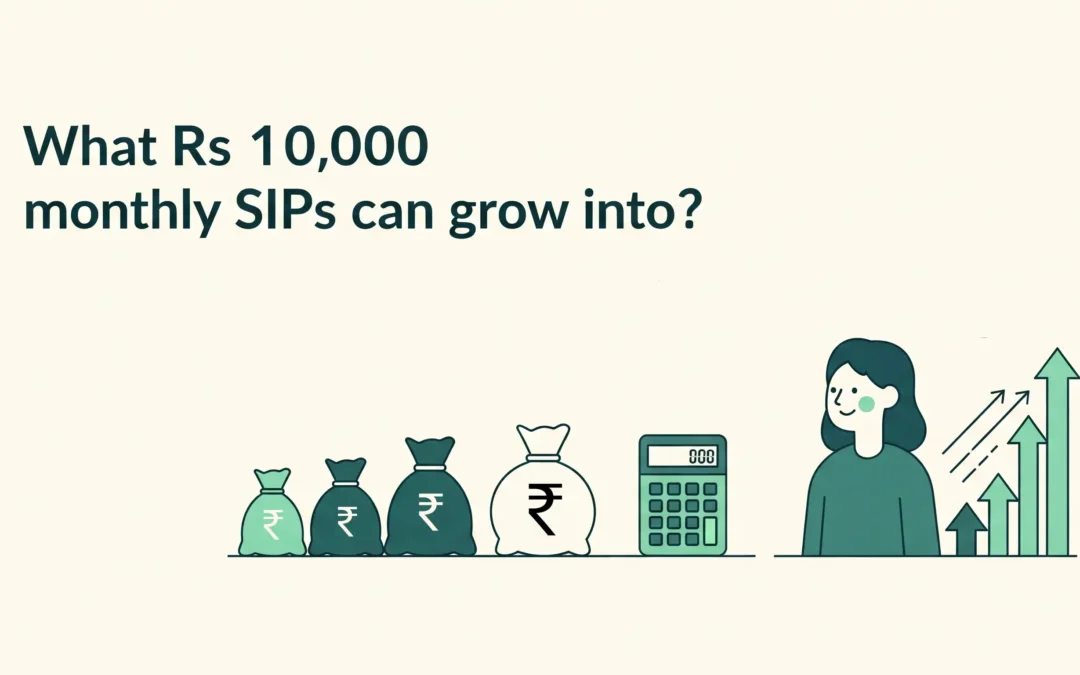Having a habit of saving from an early age is a good practice. Many individuals lack this mentality, especially when they are young. They spend more than they earn or get pocket money just to live in the moment. But, saving Rs. 10,000 monthly from an early age can be a big deal after 5-10 years of your life. This may set a difference between you and people of your age in the best possible manner.
This article will help you understand that starting an SIP of Rs 10,000 monthly can help you a lot.
Why SIPs Are a Wise Investment Option?
You can invest a set amount in mutual funds on a regular basis with Systematic Investment Plans (SIPs). By using rupee cost averaging, this strategy not only encourages saving but also capitalises on market volatility. SIPs enable you to take advantage of compounding’s power over time.
Features of SIPs:
- Investing with discipline: Prevents market timing and automates savings.
- Compounding power: Over time, returns on returns accumulate.
- Affordability: Begin with as little as Rs 500.
- SIPs allow you to invest regularly in different types of mutual funds—equity, debt, or hybrid. Diversification depends on your fund selection, not the SIP itself.
How Much Can Rs 10,000 Monthly SIP Grow Into?
Seeing how modest, regular contributions can grow into a sizable corpus over time is one of the most thrilling aspects of investing with SIPs. By investing Rs 10,000 per month, you’re doing more than simply putting money aside; you’re allowing compound interest to work for you.
Three important factors determine how much wealth you actually accumulate:
- Investment Duration: Your money compounds more the longer you keep it invested.
- Rate of Return: Over time, equity mutual funds typically produce larger returns than debt funds.
- Consistency: The compounding effect is lessened when SIPs are skipped or withdrawals are made midway.
Assuming an annual return of 10%, which is common for mutual fund portfolios based on risk appetite, let’s use examples to illustrate this.
FV= [P × r(1+r) n −1/ r]×(1+r)
- FV = Future Value
- P = Monthly investment (Rs 10,000)
- r = rate of return monthly = 10% annual / 12 months = 0.00833
- n = tenure = 5 years × 12 = 60 months
FV= [10,000 × 0.00833(1+0.00833)60−1/0.00833] × (1+0.00833)
| Time Horizon | Total Invested (Rs) | Future Value (Rs) | Wealth Gain (Rs) |
| 5 Years (60 months) | 6,00,000 | Rs. 7,83,000 | Rs. 1,83,000 |
| 10 Years (120 months) | 12,00,000 | Rs. 20,65,000 | Rs. 8,65,000 |
| 15 Years (180 months) | 18,00,000 | Rs. 41,98,000 | Rs. 23,98,000 |
| 20 Years (240 months) | 24,00,000 | Rs. 76,55,000 | Rs. 52,55,000 |
| 25 Years (300 months) | 30,00,000 | Rs. 1,29,50,000 | Rs. 99,50,000 |
Note: Actual mutual fund returns can vary. 10% p.a. is a reasonable, moderate estimate for equity mutual funds, but it is not guaranteed. Debt funds deliver lower returns.
What You Can Achieve with an Rs 10,000 SIP?
Your SIP of Rs. 10,000 can assist you in reaching several financial milestones through the power of compounding and steady investing. Let’s examine how, depending on various timeframes, this monthly habit can result in tangible accomplishments:
1. Financing Education (10–15 Years)
Today’s education is costly, whether it’s for your child’s post-graduation studies or an MBA overseas.
- Your Rs. 10,000 SIP can increase to about Rs. 20 – 21 lakhs after ten years.
- It can increase to almost Rs 42 lakhs after 15 years.
- The accumulated amount is huge, and you can use this amount of money to cover your tuition, lodging, and travel costs.
2. Buying your dream house (5–10 years)
Although owning your ideal home might seem like a significant accomplishment, it is completely achievable with a consistent SIP of Rs 10,000 per month.
- You could accumulate a fund of about Rs 7.8 lakhs in 5 years.
- At a 10% yearly return, this sum could increase to over Rs 20 lakhs in ten years.
- This means having a sizable down payment saved for when the time comes to make a purchase.
- It can take care of interior design, registration, or even drastically lower your home loan balance.
3. Establishing a Retirement Fund (20–25 Years)
Imagine living life on your terms and retiring stress-free. This could be a plan, not a wish, with a long-term investment of Rs 10,000 per month in a systematic investment plan.
- Your investment can increase to approximately Rs 76–77 lakhs in 20 years.
- Assuming a 10% yearly return, it can surpass Rs 1.29 crore in 25 years.
- This amount can contribute significantly to a comfortable retirement. However, the actual sufficiency depends on factors like inflation, lifestyle, healthcare costs, and other income sources.
4. Purchasing a Vehicle Without Taking Out a Loan (3–5 Years)
Do you plan to purchase a car without falling into any loan traps? The solution may be a short-term SIP. A nominal amount of Rs. 10,000 a month can yield:
- Approximately Rs 4 lakh in three years if invested in equity mutual funds at an assumed 10% annual average return.
- Over five years, SIP can increase to about Rs 7.8 lakh.
- This amount can help you buy your first car without a loan, which is a big deal for many individuals.
- The tension of repaying the loan and the expense of interest payment is completely eliminated.
5. Good Emergency Fund
- Your safety net is an emergency fund, which you can create with even a portion of your Rs 10,000 SIP.
- You can accumulate around Rs 2 lakh to Rs 2.15 lakh in three years if you allocate Rs 5,000 per month to liquid funds or short-term debt funds, assuming an annual return of about 6–7%. Liquid and short-term debt funds are lower risk, but their returns are typically below those of equity funds.
- These funds offer easy access when needed and are comparatively low risk.
- This fund provides you with financial security and peace of mind in the event of an unexpected bill, medical emergency, or abrupt job loss.
Bottomline
The conclusion can be drawn that starting an SIP at an early age can be of great benefit in the later stages of life. Starting a Rs. 10,000 SIP can help you build huge capital that can help you buy a car without a loan, help in buying your dream home, give you a comfortable retirement, or act as a saviour at the time of an emergency.
However, choosing the right fund is important. Align your objective with the investment option you have chosen and then decide.


